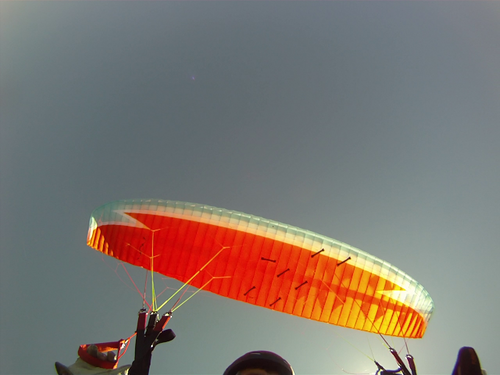Ion 2 M |
|||||||||||||||||||||||||||||||||||||||||||||||||||||||||||||||||||||||||||||||||||||||||||||||||||||||||||||||||||||||||||||||


|
|||||||||||||||||||||||||||||||||||||||||||||||||||||||||||||||||||||||||||||||||||||||||||||||||||||||||||||||||||||||||||||||
Instability rating |
|||||||||||||||||||||||||||||||||||||||||||||||||||||||||||||||||||||||||||||||||||||||||||||||||||||||||||||||||||||||||||||||
|
|||||||||||||||||||||||||||||||||||||||||||||||||||||||||||||||||||||||||||||||||||||||||||||||||||||||||||||||||||||||||||||||
Glider characteristics |
|||||||||||||||||||||||||||||||||||||||||||||||||||||||||||||||||||||||||||||||||||||||||||||||||||||||||||||||||||||||||||||||
|
Launch preparations: easy
launch characteristics: balanced, climbs constantly, no guidance necessary, good feedback during inflation, moderate braking required, control check simple, low takeoff speed
asymmetric collapse: moderate dynamics, total course change 180-270°, (3), moderate course change rate, moderate forward pitching 45-60°, (2), high height loss 40-49 m, (3), moderate sink velocity 15-19 m/s, (2), G-Force < 2,5 G, (1)
Frontal collapse: canopy collapses with high total collapse aera, moderate pitch backwards 30-45°, moderate pitch forwards 30-45°, moderate dynamics, course change <90°, (2), variable recovery behaviour, at times immediate, at times delayed, automatic recovery, (3), usually symmetric recovery, horseshoe, wingtips at front, delayed return to normal airspeed, short deep stall phase, with tendency to cravat, (4), high height loss 40-49 m, (3), low sink velocity 10-14 m/s, (1)
Spiral dives: moderate sink velocity increase, High G-Force 4,0-4,5 G, (3), Sink velocity after 720° <18 m/s, (3), High maximum sink velocity < 22 m/s, (3), sink velocity increase < 6 m/s on brake release, (2), Course change 180-360° after spiral exit, (2), moderate height loss during recovery 30-60 m, (2)
B-Stall: normal force required, marked pitch backwards 30-45°, moderate pitch forwards 15-30°, stable sink phase, low deformation tendency, immediate return to normal airspeed, 8-10 m/s, height loss on recovery 20-40 m
big ears: simple initiation, stable flight phase, immediate automatic recovery, Vsink unaccelerated 2,5-3 m/s, Vsink accelerated 3,5-4 m/s, Vunaccelerated 0-3 km/h less than trimspeed, Vaccelerated 3-5 km/h faster than trimspeed |
|||||||||||||||||||||||||||||||||||||||||||||||||||||||||||||||||||||||||||||||||||||||||||||||||||||||||||||||||||||||||||||||
Notes |
|||||||||||||||||||||||||||||||||||||||||||||||||||||||||||||||||||||||||||||||||||||||||||||||||||||||||||||||||||||||||||||||
|
Launch Characteristic: The Ion 2 starts well too, but requires a clear brake input to stabilize at the zenith. Asymmetric Collapse: The Ion 2M demonstrated typical behavior for their respective LTF classes. Front Collapse: The Ion 2 reacts well to smaller frontal collapses up to about 40% of the span, but does demonstrate a tendency to fold at the middle of the canopy. This tendency becomes marked after a complete front collapse across the entire span, the canopy horseshoes, may rotate and requires significantly longer to recover. The wing ends may tangle and cravat in the lines during this. Spiral Dive: Generally not problematic, high G-force. Big Ears: All tested gliders mastered this manoeuvre without any problems. The highest sink velocities (3.5-4.5 m/s) were measured on Novas Ion 2 due to its 2 A-line construction. |
|||||||||||||||||||||||||||||||||||||||||||||||||||||||||||||||||||||||||||||||||||||||||||||||||||||||||||||||||||||||||||||||
Rating |
|||||||||||||||||||||||||||||||||||||||||||||||||||||||||||||||||||||||||||||||||||||||||||||||||||||||||||||||||||||||||||||||
|
Safety class 4 This class of paraglider reacts demandingly to one or more of the following manoeuvres: frontal collapse, asymmetric collapse or spiral dive.Demandingly means that the above manoeuvres result in marked dynamic reactions from the glider and/or large height losses. Advanced piloting skills which need to be regularly practised, together with good personal reaction times are required to safely fly this class of gliders. Basic recovery techniques for ending a manoeuvre are not sufficient to maintain control, reduce height loss to a minimum and prevent subsequent critical reactions. Pilots should be able to recognise the onset of the above manoeuvres and be able to prevent or minimise their effects through immediate and precise pilot inputs. Additional experience such as regular ground handling and SIV training is required to safely fly gliders of this class. Special training or pilot skills which exceed standard training may be required for the safe performance of emergency descent techniques. Gliders of this Safety Class are not suitable for beginners, irregular flyers or low-airtime pilots. |
|||||||||||||||||||||||||||||||||||||||||||||||||||||||||||||||||||||||||||||||||||||||||||||||||||||||||||||||||||||||||||||||

